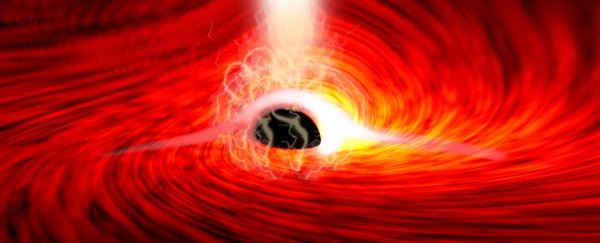So extreme is the magnetic and gravitational environment around a black hole that we should see light bend around it and be reflected back at the viewer from behind the black hole – at least, per the theoretical predictions of Einstein's general relativity.
Now, for the first time, astronomers have directly detected this reflected light, in the form of X-ray echoes from a supermassive black hole 800 million light-years away, in a galaxy called I Zwicky 1 (I Zw 1). This finally confirms Einstein's prediction, and sheds further light on the darkest objects in the Universe.
"Any light that goes into that black hole doesn't come out, so we shouldn't be able to see anything that's behind the black hole," said astrophysicist Dan Wilkins of Stanford University.
"The reason we can see [the X-ray echoes] is because that black hole is warping space, bending light and twisting magnetic fields around itself."
There are several components to the space immediately surrounding a black hole. There's the event horizon – the famous "point of no return", at which even light speed is not sufficient to attain escape velocity.
An active black hole like I Zw 1* also has an accretion disk. That's a huge flattened disk of dust and gas swirling into the object, like water circling a drain.
This disk gets incredibly hot due to the frictional and magnetic field influences – so hot that electrons are stripped from atoms, forming a magnetized plasma.
Just outside the event horizon of an active black hole, inside the inner edge of the accretion disk, is where you'll find the corona. This is a region of scorchingly hot electrons thought to be powered by the black hole's magnetic field.
The magnetic field gets so twisted that it snaps and reconnects – a process that, on the Sun, launches powerful eruptions. In a black hole, the corona acts like a synchrotron to accelerate the electrons to such high energies that they shine brightly in X-ray wavelengths.
"This magnetic field getting tied up and then snapping close to the black hole heats everything around it and produces these high-energy electrons that then go on to produce the X-rays," Wilkins explained.
Some of the X-ray photons irradiate the accretion disk and are reprocessed, via processes like photoelectric absorption and fluorescence, and then re-emitted – in what is called a reverberation echo, and referred to as a 'reflection' in the X-ray spectrum. This reflection emission can be used to map the region closest to the event horizon of a black hole.
It was the mysterious corona that Wilkins and his team were looking to study when they commenced their examination of I Zw 1*. They took observations of the galaxy in January 2020 using two X-ray observatories, NUStar and XMM-Newton.
They saw the expected X-ray flares in the data, but then they found something they weren't expecting – smaller, later flashes of X-ray light in a different part of the spectrum.
These, Wilkins realized, were consistent with reflections coming from behind the black hole, with their paths bent around the massive object by its incredibly strong gravitational field, and their light magnified.
"I've been building theoretical predictions of how these echoes appear to us for a few years," Wilkins explained. "I'd already seen them in the theory I've been developing, so once I saw them in the telescope observations, I could figure out the connection."
It's gratifying, once again, to confirm another key prediction of general relativity, but the discovery is exciting for a couple of other reasons, too.
For one, it's really awesome to find out anything new about black holes. They're such tricky cosmic beasties – being invisible, and with the space around them so extreme – that observational studies are quite challenging.
It's also a measure of how far we've come, that we can make these kinds of granular observations, both with our instrumentation and our analytical techniques. Black hole science is, the researchers say, only going to get better, with a new generation of telescopes poised to open their eyes on the skies.
"The picture we are starting to get from the data at the moment is going to become much clearer with these new observatories," Wilkins said.
The research has been published in Nature.
